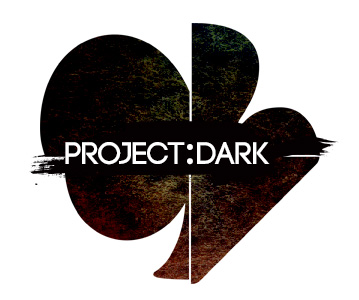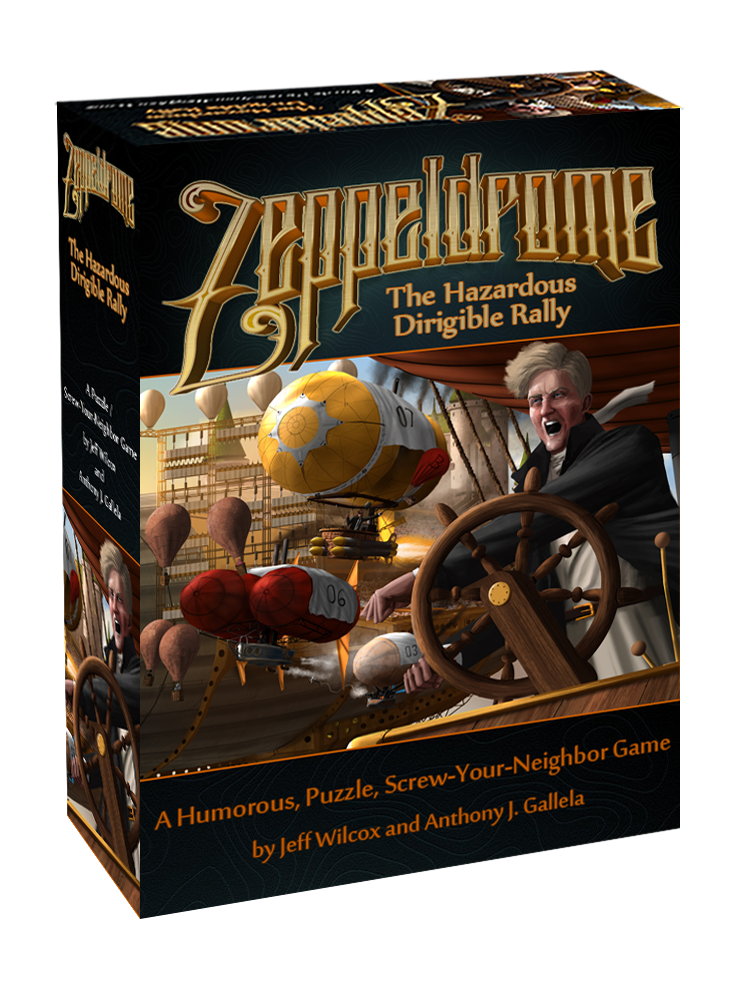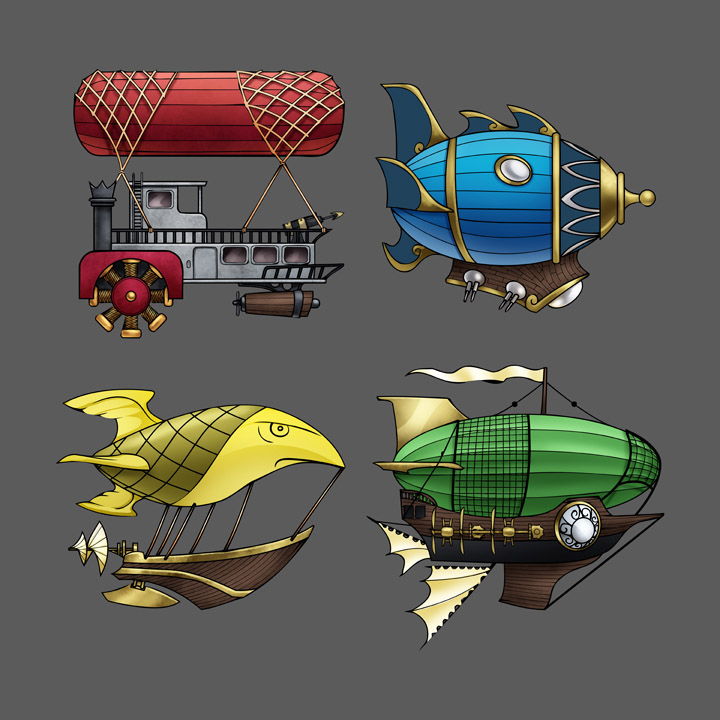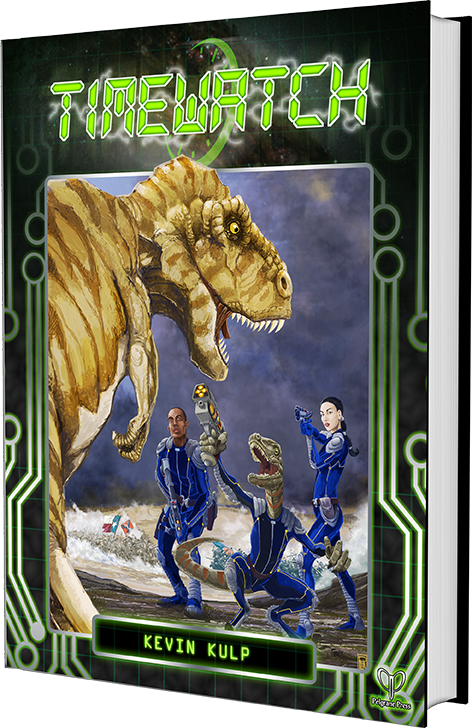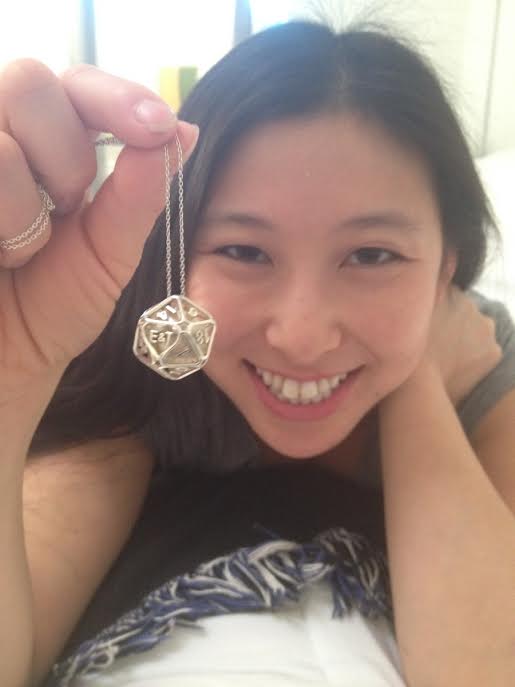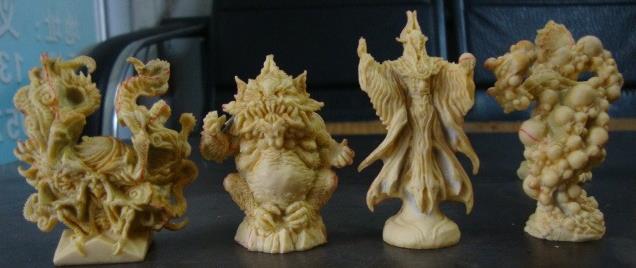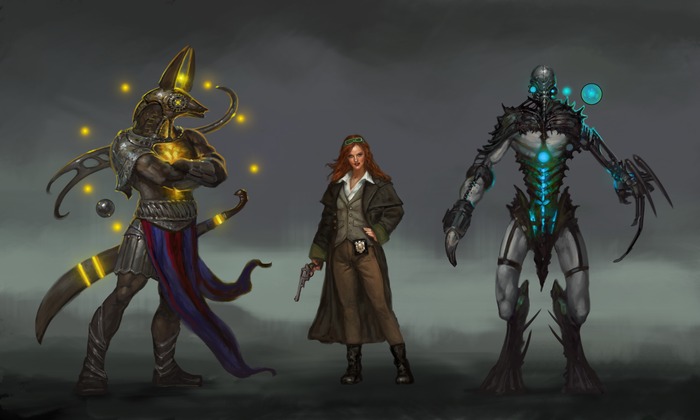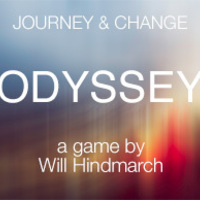I’m heading to sea on the JoCoCracy Cruise 4, so I will be offline for a while. When I return, expect more Stories & Dice and my delayed report on my Eberron D&D Next experience!
Things I’m Backing: Games
For some reason, January 2014 was the Month Of Kickstarters. Ever day seemed to bring a new project I had to back. There’s too many projects for me to discuss in a single post, but if I don’t write something soon time will run out, so let’s get started!
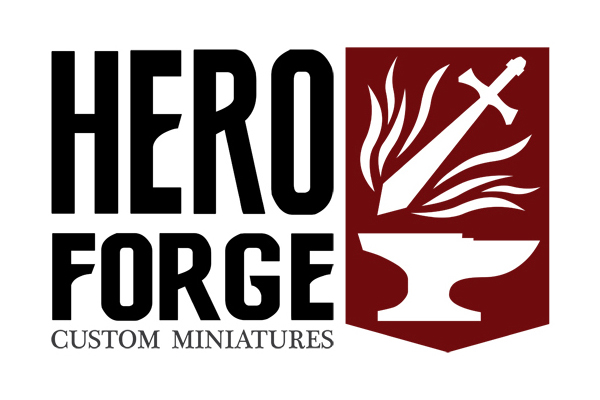 HERO FORGE: CUSTOMIZABLE 3D PRINTED MINIATURES
HERO FORGE: CUSTOMIZABLE 3D PRINTED MINIATURES
I’ve always been a sucker for miniatures. Like many others, I backed Reaper Miniatures’ Bones campaign, and was thrilled when the huge box of minis finally arrived. Hero Forge is a different sort of animal. Rather than offering quantity, Hero Forge offers the chance to create a miniature tailored specifically to your needs. More often then not, I ended up using a miniature that is close to my character, but not quite right… wrong weapon, wrong armor, SOMETHING I’d like to change. Hero Forge aspires to solve that problem. Using an online tool, you select from different poses, equipment, race, gender… hopefully finding the perfect match. The miniature you design is then printed in plastic (or other materials) and sent your way. Obviously there are limitations; you can only choose from the poses, equipment and races they provide, so my dreams of the warforged fighter wielding a Talenta tangat are off the table… at least for now. But there’s a wealth of options, and an opportunity to create a miniature that truly feels like a personal representation of your character. And as time goes on, they will be continuing to expand the library of parts, both expanding the existing lineup and adding new genres. They’ve already committed to Wild West and Sci-Fi lineups; Pulp/Noir, Steampunk, and other genres are just around the corner.
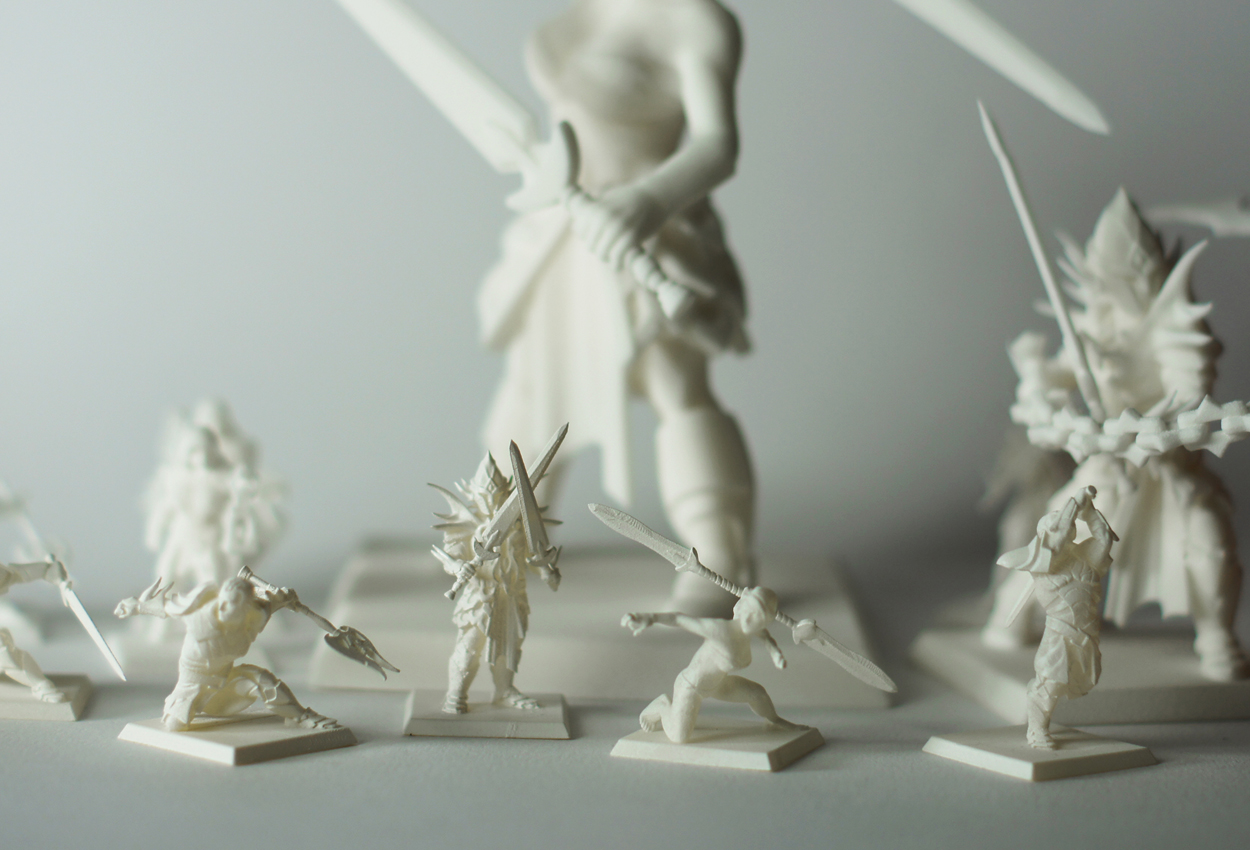 Hero Forge isn’t a cheap way to get a figure; depending on the material and number of figures you select, you’re putting anywhere from $15 – $30 into a single miniature. With that said, I’ve had a chance to examine Hero Forge miniatures directly, and I’m impressed with the quality and variety of the figures. Hero Forge isn’t about quantity. I wouldn’t use Hero Forge if I needed thirty goblins that will likely be wiped out in a single fireball. But when it comes to representing a specific individual, it’s a fantastic opportunity. I have to be honest: I never end up using most of the miniatures I purchase. Quite often I’m chasing one specific figure, and it comes with others that I simply never need. A Hero Forge figure may cost as much as a half dozen premade-minis… but it’s exactly the figure I want it to be, and I know I’m going to use it.
Hero Forge isn’t a cheap way to get a figure; depending on the material and number of figures you select, you’re putting anywhere from $15 – $30 into a single miniature. With that said, I’ve had a chance to examine Hero Forge miniatures directly, and I’m impressed with the quality and variety of the figures. Hero Forge isn’t about quantity. I wouldn’t use Hero Forge if I needed thirty goblins that will likely be wiped out in a single fireball. But when it comes to representing a specific individual, it’s a fantastic opportunity. I have to be honest: I never end up using most of the miniatures I purchase. Quite often I’m chasing one specific figure, and it comes with others that I simply never need. A Hero Forge figure may cost as much as a half dozen premade-minis… but it’s exactly the figure I want it to be, and I know I’m going to use it.
As of today, Hero Forge has been funded and already reached numerous stretch goals. I’ve seen their products and have no doubt that they will follow through with it. Time is running out, so if it interests you, check it out today!
As a professional designer, there’s a handful of people whose work consistently amazes me… people who inspire me and make me want to do more with my own designs. Will Hindmarch is one of those people. His cyberpunk epic Always/Never/Now is one of my all-time favorite roleplaying experiences. Now he’s launching a new game, Project: Dark. Personally, I think there’s an abundance of good systems out in the world, from the many flavors of D&D to Fate, Cortex, WaRP, Savage Worlds, GURPS, and on and on. As a result, it takes a lot to get me interested in an entirely new system. I want a reason for new mechanics… for the system to create a play experience that I simply couldn’t replicate with a difference system. And that’s what Dark does. It’s not a general-purpose system. It’s designed to tell a very specific sort of story – a story focused around stealth and exploration, about devising the perfect plan and creeping through the shadows to carry it out. While it’s designed for a certain style of adventure, it’s not tied to a single setting; currently it will include three distinct settings, each well-suited to the sort of stories the system does best.
I’ll be talking with Will Hindmarch about Dark in more detail in the next few weeks, so keep an eye out for that. The project is already fully funded with a few weeks to go, and it’s not Will’s first foray into Kickstarter. This is a project that’s going to happen, and a game worth checking out. So do it already!
From the minds of Anthony Gallela and Jeff Wilcox comes Zeppeldrome, The Hazardous Dirigible Rally. If you’re like me, you’ve been bemoaning the horrifying dearth of dirigible-based board games on the market today (though there’s a surprising surge in dirigible games on Kickstarter!). Zeppeldrome doubles down on this concept, as it’s a dirigible race in which the racecourse is itself in an even larger dirigible. This isn’t just a load of hot air, folks. Well, it is, but it’s also an intriguing game involving a modular board, pre-planned movement, and the ability to interfere with your opponent’s preplanned movement, while remaining casual and fun. So if you’ve been hankering for a quality game about humorously awkward airships, take a look!
I’ve always loved time travel. As a kid I ran into it through Peabody & Sherman’s Wayback Machine and Ray Bradbury’s “The Fox and the Forest”, and made my way to The Anubis Gates, TimeWars, The Sarah Connor Chronicles, and so much more… I love it all. At the same time, I’ve never actually run a roleplaying game based around the concept. And more often than not, I’ve been frustrated by stories that feature time travel without truly considering the consequences of the technology. Kevin Kulp’s TimeWatch tackles both of these; it’s a brilliant time travel RPG that dives into all the issues that I find intriguing about the concept. TimeWatch is based on Robin D. Laws’ GUMSHOE system, tuned in various ways to fit the concept. As a TimeWatch agent, it’s your job to protect history from a myriad host of threats. Greedy Humans? Check. Radioactive cockroaches from the future trying to engineer nuclear war? Check. In any given mission, it’s up to you to figure out how history has been altered and what you need to do to resolve the problem. Like Project: Dark, TimeWatch has already been funded and already blown through multiple stretch goals, and it’s still got a week to go. If you like time travel, this is definitely worth a look!
Phew! That’s all for today, but that’s just the GAMES I’ve backed this month. I’ll be back later this week with a few more projects to check out. In the meantime, let me know what YOU’RE backing!
Stories & Dice: Erika and Teagan
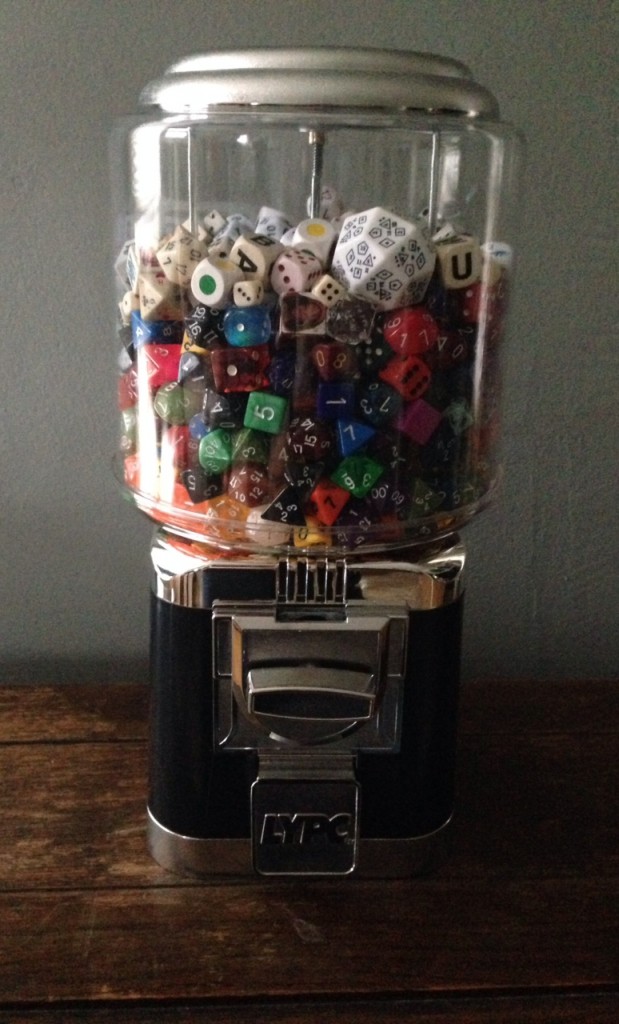 In December 2013, my wife gave me a gumball machine filled with dice. There’s a little space at the top, and rather than fill it myself I decided to turn to you. I want you to send me a die and a story. It could be a story about the die itself, or just about you: who you are and why you play games. Traveling around the world, I’ve found that gamers cover an amazing spectrum – teachers and students, celebrities and children, strippers and soldiers. Everyone has a story, and I’d like to share yours.
In December 2013, my wife gave me a gumball machine filled with dice. There’s a little space at the top, and rather than fill it myself I decided to turn to you. I want you to send me a die and a story. It could be a story about the die itself, or just about you: who you are and why you play games. Traveling around the world, I’ve found that gamers cover an amazing spectrum – teachers and students, celebrities and children, strippers and soldiers. Everyone has a story, and I’d like to share yours.
 I met Teagan and Erika during my recent trip to LA. Erika is an actress; Teagan is the Technical Art Director at Naughty Dog, a video game developer that’s produced a few obscure titles you’ve probably never heard of (Uncharted, The Last Of Us, Crash Bandicoot). Their home is filled with games, custom miniatures, and more NERF guns than I’ve ever seen in one place… and I’ve seen a lot of NERF in my time. They gave me a remarkable die that Teagan had actually made himself. I’ll let him tell the story.
I met Teagan and Erika during my recent trip to LA. Erika is an actress; Teagan is the Technical Art Director at Naughty Dog, a video game developer that’s produced a few obscure titles you’ve probably never heard of (Uncharted, The Last Of Us, Crash Bandicoot). Their home is filled with games, custom miniatures, and more NERF guns than I’ve ever seen in one place… and I’ve seen a lot of NERF in my time. They gave me a remarkable die that Teagan had actually made himself. I’ll let him tell the story.
Perfect gifts sometimes only happen when everything falls into place. We’d been hard at work on a custom miniatures startup “Hero Forge” we planned on Kickstarting come the new year. We’d received a few test prints back already so I was pretty familiar with the process of sending 3D models off to get 3D printed. I turned to finding a Christmas gift for my lovely and vivacious D&D partner and girlfriend Erika Ishii. It needed to somehow compensate for how absent I’d been putting so much work into the Kickstarter! A custom made silver D20 that could be worn as a necklace was the perfect intersection of beautiful jewelry and functional nerd culture. The 20 was replace with an E&T encased in a heart. Cheesy but… “critical hit to the heart cheesy” according to Erika. She was ecstatic, and insisted on wearing it nearly all the time. By the end of our New Year’s party she had bruises where the dice was around her neck from all the hugs she’d been getting!
The dice I’m sending you for your dice machine is a test print before I ordered it in full silver. It’s the exact same material we’re printing our Hero Forge miniatures in! 3D printing is going to bring so much personalization and meaning that was just not possible before. We’re very excited about what the future holds… although Erika might want to avoid wearing the necklace during celebrations where there’s frequent hugging.
Teagan started playing games at an early age, but there were religious restrictions on what his parents would allow in the household. As a result he made his own games, crafting books of puzzles and mazes. The Legend of Zelda: The Ocarina of Time was a defining experience for him, drawing him into a new and magical world. While video games have played a central role in his life and career, tabletop roleplaying has only become a passion in the last few years. In his own words: I discovered just how engaging and exciting it is to collectively tell a story with your friends while face to face. There’s a power there that video games just aren’t advanced enough to provide. Seeing the emotion in your friends’ faces and participating in the back and forth. It’s powerful stuff!
By contrast, Erika’s first brush with roleplaying came as a sophomore in high school, when a friend handed her the 3rd Edition Player’s Handbook and said it was the game she was meant to play. Apparently he was correct. Erika was captivated by the game and read the PHB cover to cover, and generated a host of characters. This continues to be one of the most compelling parts of the gaming experience today. She’s not a min-maxer or rules lawyer, but she puts a great deal of time and effort into developing elaborate character backstories and roleplaying her characters’ tics and motivations… even when they aren’t beneficial to her as a player. More than anything, what she loves is the experience of collaborative storytelling… hearing and shaping living, organic stories with her friends.
Both Erika and Teagan have plans for the world of gaming. Teagan is especially interested in finding ways to blend technology and tabletop, building on the virtual tabletops that exist today and finding more ways to merge virtual aspects with the tangible… ways to maintain the vital experience of being face to face with friends even when it’s impossible. Erika would like to have a hand in making games more inclusive of women and minorities; in her words, “I think the miniature market could stand to have a few tiny people of color on the shelves… and Josh and Teagan have promised me that Hero Forge will give you the option of creating a female miniature that doesn’t have giant breasts, which is extremely novel.”
Today Teagan is in the midst of his Hero Forge campaign, and the 3D printer is churning out new figures. Erika wears the silver die on a chain around her neck, while the prototype rests at the top of the gumball machine… a symbol of love of games, but more important, of their love for one another.
Do you have a story and a die? If you’d like to take part, send both of them to Keith Baker, PO Box 13250, Portland OR 97213. Make sure to include contact information so I can get in touch with you for follow up questions!
Sundry and Geeky Gloom News
Ten years ago I made a game called Gloom. In 2012 Gloom was featured on an episode of Geek & Sundry’s awesome series TableTop, with Wil Wheaton, Meghan Camarena, Amber Benson, and Michelle Boyd. In 2013, Atlas and I teamed up with Geek & Sundry to produce a special TableTop-themed Gloom expansion, which was given away on International TableTop Day.
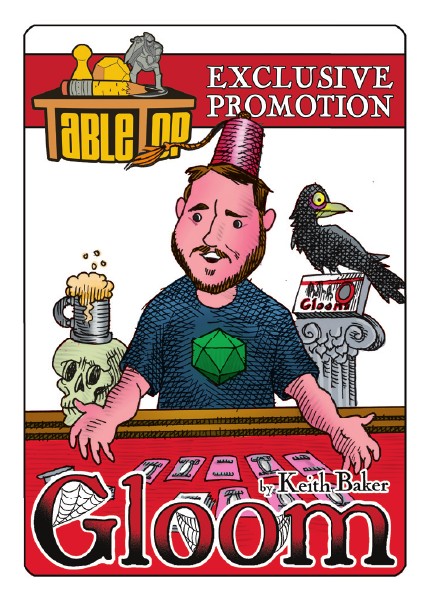 Well, it’s 2014, and International TableTop Day is happening again – on April 5th 2014! Last weekend I had the good fortune to be at the announcement party, and it sounds like Geek & Sundry still has some copies of TableTop Gloom on hand. We only did a limited run on it, so no promises that they’ll have it at any particular ITD event… but they might! So if you missed TableTop Gloom last year, look for a ITD event near you.
Well, it’s 2014, and International TableTop Day is happening again – on April 5th 2014! Last weekend I had the good fortune to be at the announcement party, and it sounds like Geek & Sundry still has some copies of TableTop Gloom on hand. We only did a limited run on it, so no promises that they’ll have it at any particular ITD event… but they might! So if you missed TableTop Gloom last year, look for a ITD event near you.
One of the highlights of the party was playing the game with Meghan Camarena – better known as Strawburry17 – her brother David, and my friend Satine Phoenix. So I got to play TableTop Gloom with one of the people who played Gloom on TableTop, which was a awesomely palindromic way to end a day. On top of which, we killed Wil Wheaton. Twice.
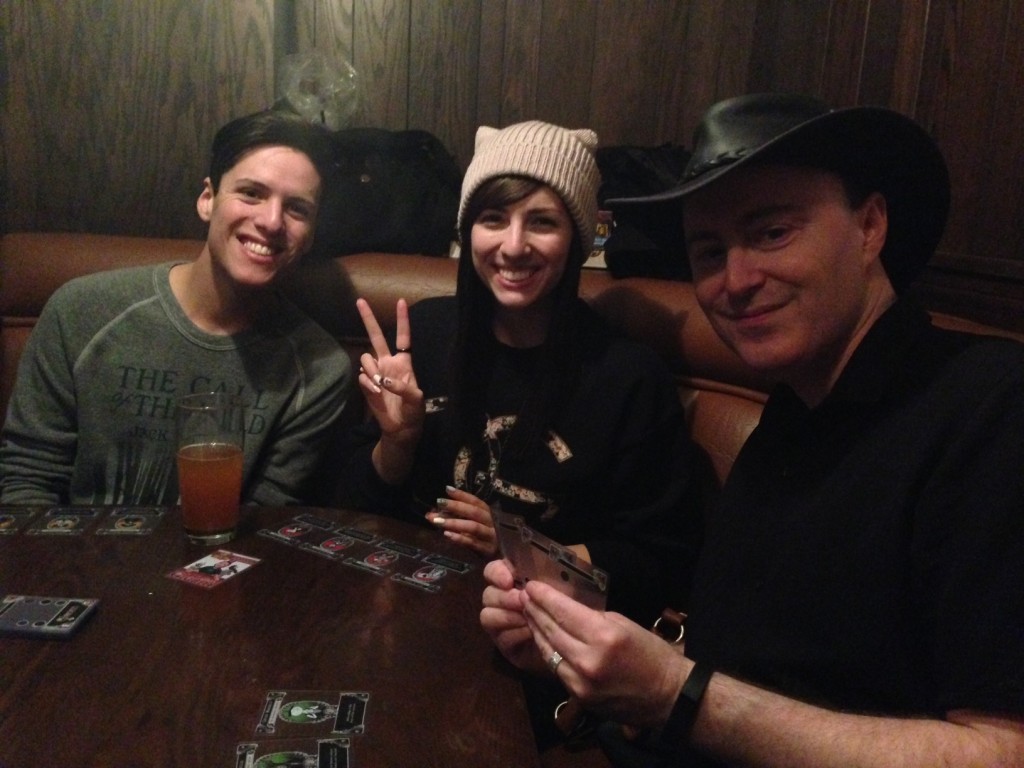 Of course, as long as I’m talking about TableTop Gloom, I’d be remiss if I didn’t post a link to the video I made last TableTop Day, with The Doubleclicks and Molly Lewis!
Of course, as long as I’m talking about TableTop Gloom, I’d be remiss if I didn’t post a link to the video I made last TableTop Day, with The Doubleclicks and Molly Lewis!
I’m working on a few Gloom-related projects that I’m not quite ready to talk about, but there is one interesting thing happening RIGHT NOW. Artist Len Peralta is producing a new series of Geek Trading cards: Geek-A-Week Year Five Two, and I’m in the roster for the set. Looking at it, my first thought was “I want to play Gloom with these cards!” I talked to Len, and if the Kickstarter hits $20,000 I’m going to put together a set of Geek-A-Week Gloom cards using his artwork. To be clear: This won’t be a fully produced expansion on translucent plastic; plastic cards are expensive to produce, especially in a small run. Instead, this will be a single sheet for you to download and print on cardstock, taking eight of Len’s geeks and translating them in guests and characters for Gloom. Since characters are always on the bottom of the stack, it doesn’t matter if they aren’t transparent. But if you’ve ever wanted to tell a terrifying story in which Patrick Rothfuss traps Neil Gaiman on a train just in time for them both to be murdered by The Doubleclicks and Anne Wheaton, help make this Gloom set a reality! Plus, it means that I’ll get to be on a Gloom card, and I’ve got some ideas for that.
 I’ve been meaning to write a Gloom Q&A for a while now, but I’ve never gotten around to it. So… what do you want to know about Gloom?
I’ve been meaning to write a Gloom Q&A for a while now, but I’ve never gotten around to it. So… what do you want to know about Gloom?
Dragonmarks: Spies, Heraldry, and a Lightning Round
When I put out a call for questions last week, I didn’t expect to get fifty of them. This has inspired me to get to work organizing previous posts, both because some of the questions people asked have already been answered and because it would be nice to have all the answers on Droaam or The Mark of Death in one place. I’m going to answer a few topics in detail today, and then do a lightning round of short answers. If your question isn’t dealt with here, it may be addressed in the upcoming reorg.
As always, my answers are entirely unofficial and may contradict canon sources. If you’re looking for official answers, you might check the Dragonshard Archive, Eberron Expanded, or Eye on Eberron.
So on to the questions!
Does Eberron have a place in the next edition? Will we ever see more novels?
Eberron certainly has a place in the new edition, but I don’t have any concrete new information about what that place will be. Warforged appeared in the playtest material, and James Wyatt has mentioned Eberron a number of times in his articles about D&D Next. However, I don’t yet know exactly what that place will be or how much support you can expect, and whether novels will be a part of it. I’ll make an announcement as soon as there is concrete news.
How’s your experience been with D&D Next? And how do you run changelings in your campaign, as a player or DM?
Given that I’m playing a changeling in the D&D Next campaign I’m in, these two questions are directly related. I’m planning to write an entire post on my adventures in DDN, and I’ll cover both these questions there.
I’m hoping for advice on two fronts; I want to diversify the various intelligence agencies (Dark Lanterns, Royal Eyes, and… who do Thrane and Karrnath have?)…
First, bear in mind that the King’s Citadel isn’t just the intelligence service of Breland. back in the day, the Citadel was the intelligence service of GALIFAR, just as the Arcane Congress was the center for mystical research for Galifar, and Rekkenmark the center for training for the armies of the united kingdom. While the Citadel employed agents from all Five Nations, the bulk of its resources and command structure were based in Breland, and the vast majority of its agents were from Breland. Just as Rekkenmark reflects the martial culture of Karrnath and Aundair’s love of the arcane is tied to the presence of the Congress, the Citadel was a source of national pride for Breland and a reflection of their pragmatic culture, and the vast majority of Citadel agents were Brelish. So the reason you hear more about the Citadel than about the agencies of other nations is because it is the oldest and largest force. Prior to the Last War, Karrnath didn’t HAVE a national intelligence agency; it had the King’s Citadel. Its current agency was built at the start of the war using those Karrnathi agents who’d worked with the Citadel and the bits of infrastructure it was able to seize. But the Citadel is a national strength of Breland… just as the Arcane Congress, Rekkenmark, and Flamekeep are all institutions that once served all nations but now benefit their home nation.
So: at the start of the Last War, the Five Nations had to come up with an individual approach to intelligence. Here’s how it broke down.
Aundair. The Royal Eyes were established by Aundair herself at the dawn of Galifar. They were her personal corps of spies established to spy on the leaders of the other nations (which is to say, Aundair’s own siblings). They maintained this mission over the centuries, an have an exceptional talent for intelligence-gathering augmented by the finest arcane divination techniques and equipment in the Five Nations. Since the Last War they have expanded their numbers and the scope of their operations. However, they don’t have the numbers or resources of the Citadel, and their strength is still divination.
Breland. The Dark Lanterns and King’s Shadows once encompassed all of Galifar. As such, they have centuries of resources and techniques at their disposal. Many of their foreign safehouses and moles were identified and eliminated over the course of the Last War – but not all of them. Their agents are both more versatile and more numerous than those of the other Five Nations, and they have no particular specialty; they can carry out any sort of operation. Breland’s strong ties to House Medani and good relationship with Zilargo are additional strengths. Short form: A Dark Lantern may not be as tough in a fair fight as a Karrnathi agent and may not have the specialized magic of a Royal Eye, but they have exceptional training and strong mission support. Karrnath has warriors, Aundair has wizards, and Breland has rogues.
Cyre. Each nation had its own strengths. Breland had the Citadel. Karrnath had Rekkenmark. Cyre had the royal treasury and mint. Initially, Cyran intelligence relied heavily on House Phiarlan and House Tharashk. As the war progressed, Cyre built up its own agencies using their own ex-Citadel agencies. One that has been mentioned in the novels is the Fifth Crown, an urban strike force specializing in infiltrating enemy territory. Cyran agencies were small and had limited strategic resources (safehouses, generational moles, etc) but were generally extremely well equipped.
Karrnath. The people of Karrnath take pride in military discipline and skill, and think little of those who would skulk in the shadows; before the Last War, few Karrns service with the King’s Dark Lanterns. In the wake of the war, Karrnath established the Twilight Brigade as a special division of the White Lion police force; members of the Twilight Brigade are sometimes called “Dark Lions”. The Brigade specializes in counterintelligence, devoting its efforts to identifying and eliminating enemy operatives; it also serves the function of “secret police”, gathering information on Karrns on behalf of the king. Karrnath thus has a limited reach when it comes to gathering intelligence in foreign nations, often relying on Phiarlan and Thuranni for such purposes; its philosophy is to deny intelligence to the enemy and then rely on its own martial strength. With that said, during the war it made use of the Raven Corps, an organization formed from Blood of Vol mystics who specialized in gathering intelligence through the use of necromancy – interrogating corpses, using shadows as spies, and so on. The Raven Corps was a volunteer force, and was disavowed and disbanded at the same time as the Emerald Claw and other Seeker orders.
Thrane. The Argentum is a branch of the Church of the Silver Flame tasked with identifying, locating, and obtaining powerful or dangerous artifacts… by any means necessary. The Argentum has carried out this mandate for centuries, and this talent for covert operations made it the logical choice to serve as the foundation for Thrane’s intelligence agency in the war. In this, the Argentum is similar to the Royal Eyes. It is a small, specialized organization that has been operating for centuries and is highly skilled at a specific type of mission, which has now been given greater resources and drafted to perform other operations. As such, it’s on par with the Royal Eyes in terms of resources and scope, and still trailing behind the Citadel. Where the Royal Eyes specialize in information gathering, the Argentum excels at theft and extraction, and has access to the warehouse of dangerous artifacts its gathered over the centuries.
… and need a little help coming up with potential hot spots in a cold war across Khorvaire.
A personal favorite of mine isThaliost. Once a major Aundairian city, it’s now controlled by Thrane. They placed an Aundiarian bishop in charge of the city, but his zealous excesses have exacerbated a delicate situation. Violence is inches away, and there’s certainly opportunity to push things one way or the other and to threaten Thrane or Aundair.
Droaam is also good, as you can see in my novel The Queen of Stone. There’s all sorts of topics that could come up: its desire to be recognized, the threat of hostility against Breland, the activities of Daask, Droaam harboring war criminals or political refugees, a nation trying to secure a military or economic alliance with Droaam (which is sitting on many useful resources), or even Sora Teraza announcing that she has a collection of secrets that could topple governments and she’s going to release it next week – do you steal it? Destroy it? Protect it from other nations?
Stormreach has many of the same possibilities as Droaam. A nation could be pursuing a strategic resource in Xen’drik, funding an extremist group operating out of Stormreach, conducting secret business with Lyrandar, etc.
Beyond that, you can have themes that could occur anywhere. Any sort of serious research on the cause of the Mourning is a serious cold war threat; it’s the Manhattan Project all over. Any form of significant arcane research could be nearly as significant an issue – anyone creating something that could give them a position strong enough to start the war anew. This could be creation of a new spell or weapon, an alliance with Argonnessen, Aerenal, or Riedra, something that would cripple another nation (say, extinguishing the Silver Flame), etc.
Do the Dragonmark Houses place any honor, taboo, or significance on their standard beast? For example, would a Thuranni killing a displacer beast be seen as bad form?
It varies by house. The tradition of house heraldry is tied to the Twelve; bear in mind that Thuranni, for example, was Phiarlan until just a few decades ago, so they haven’t had long to build up a particular attachment to their heraldic beast. In some cases the beast was chosen by the house because it was a creature they already had an attachment to or use in some way. For example, in the Talenta Plains the blink dog has a reputation for helping stranded travelers; “ghallanda” actually means “helpful hound who appears where needed the most.” House Tharashk took the dragonne both because it is a fierce predator, but also because it’s a “dragon-that’s-not-a-dragon”; this is a reflection of their general view of themselves as outsiders (also reflected by their willingness to overlap Deneith and Vadalis in their dealings with Droaam). The cockatrice of Sivis can be seen as “the deadly quill.” For the most part the beast is chosen for what it represents, not because the house has a literal relationship with it. However, Kundarak does make use of manticore cavalry, and Lyrandar legends say that the spirits of Lyrandar elders linger as krakens in the depths.
So for the most part, a Thuranni killing a displacer beast would be like a Republican killing an elephant – a humorous coincidence, but not a dishonorable act.
However, if you WANTED to take it further you could certainly decide that there is a greater significance to the beasts. Perhaps each house truly does have a totem spirit, something that revealed itself to the founders of the houses… an incarnation of the power of the mark that can choose to manifest in the wild beasts. So not every gorgon has a tie to Cannith… but any gorgon could suddenly speak to a Cannith heir and offer them advice or call on them for a favor. It could be very interesting to say that there IS a sentience to each mark; the real question then is what it means that the Mark of Shadow has two beasts.
What, if any, was the totem beast for the Mark of Death? Or was the mark eradicated before it had a chance to be a proper House?
Per canon, the line of Vol was never a “Dragonmarked House”. The traditions of the houses were established and standardized by the Twelve, and the line of Vol was exterminated long before that. If you run with the idea that the beasts are more than mere symbols, then it would make sense for the mark to have a totem beast. One possibility would be for that beast to be undead, but I wouldn’t go that way; all the others are magical beasts, and I’d look for a beast that is in some way associated with the dead.
OK: there’s a lot of good questions, but too many for me to answer in depth. So it’s time for a LIGHTNING ROUND! When I do the reorg I may expand on some of these, but for now I’m keeping it quick.
Since the code of Galifar is not applicable in Xen’drik, do the Sentinel Marshals find obstacles and is their jurisdiction denied by the storm lords in Stormreach?
Sentinel Marshals have no official jurisdiction in Stormreach and the Storm Lords could block them. However, consider that Sentinel Marshals are honored members of House Deneith. Blocking the actions of a Marshal is thus spitting on House Deneith… which could be seen as insulting the Twelve. Is this situation worth the danger of economic reprisals from the Houses? In short, the Storm Lords COULD block a marshal, but I’d only expect them to do it for a VERY good reason.
What Icons would you use for an Eberron 13th Age game?
Lucky for you, I addressed this in a previous post!
Can you get Randy Lander to start up our game again?
Yes. If he knows what’s good for him. I’ve got your number, Randy.
Where can I find out more about Darguun? What is society like there? Tech level? Cultural idiosyncrasies?
At the moment, your best bet is to read Don Bassingthwaite’s novels, such as Legacy of Dhakaan.
Was the Undying Court ambivalent to the daelkyr invasion of the Dhakaani empire? Or busy with some other pressing business at the time?
Excellent question that deserves more than a lightning round answer, but that’s all the time I’ve got for it. Short answer: The power of the Undying Court is concentrated in Aerenal. They undoubtedly took action to defend Aerenal from the incursion. The Dhakaani had already fought the Tairnadal and driven them from Khorvaire, so there was no love between elf and goblin; even if the Court had the power to help Dhakaan, it’s not much of a surprise that they chose to focus on their own defense.
Is there any evidence to support the claim that the daelkyr were refugees seeking asylum in Eberron and that the Dhakaani empire was the one to initiate hostilities, forcing the daelkyr to respond in self defense?
None at all. You may be thinking of the theory that the Quori were refugees seeking asylum in Eberron when they were attacked by the Giants; there’s a fair amount of evidence suggesting that, and more important, neither culture survived to the present day, so there’s no way to verify it. Meanwhile, we have the Gatekeepers, Heirs of Dhakaan, and the Daelkyr themselves as multiple living threads attesting to the hostile intent and actions of the Daelkyr. With that said, it can be argued that the Daelkyr don’t consider collapsing civilizations and warping creatures into new forms to be a hostile act. You might consider this Dragonmark:
Are there Gatekeepers corrupted by the Daelkyr?
Certainly. “Gatekeepers corrupted by the Daelkyr” is an entirely valid foundation for a Cult of the Dragon Below. Consider the link above.
What would it take for Droaam to be accepted as a nation the way Darguun has been?
Good question, and one that’s explored in my novel The Queen of Stone. You might also look at the following Dragonmark:
Droaam and the Daughters of Sora Kell
Who fathered the Daughters of Sora Kell? Do they have any favorite children of their own?
They each have different fathers, which is why they are all different types of hags. The identities of their fathers have never been revealed in any canon source. No children have ever been mentioned in a canon source, though you might find a possibility in the comic Eye of the Wolf.
How would the Daughters of Sora Kell react if the Queen of Stone was assassinated?
The main question is if they were aware of it in advance or orchestrated it themselves. Remember that Sora Teraza is the most gifted oracle of the age, so you can be sure SHE’D know; the question is if she shared the information with her sisters. Personally, my feeling is that if they allowed it to happen it’s because it helps them in some way. They could have allowed it in order to replace her with a more pliable warlord. It could be a calculated move to create a martyr to inspire their forces or to demand concession from the nation of the assassins. I’d check that Dragonmark about and consider what the motives of the Daughters are in your campaign.
I watched Game of Thrones seasons 1-3. I noticed quite a lot of parallels between it and the Eberron setting. Is Eberron more than just a little inspired by A Song Of Ice And Fire?
My original pitch for Eberron was “Lord of the Rings meets Raiders of the Lost Ark and The Maltese Falcon.” If I wrote that today, I’d probably substitute Song of Ice and Fire for LotR, because there are lots of similar aspects; stories don’t always end well, there’s more shades of gray than black and white morality, and hey, a terrible civil war. I can only imagine that I hadn’t really gotten into SoI&F when I was first working on Eberron. With that said, there are major differences. One of the central themes of Eberron is exploring the impact of magic on civilization, while Westeros is a low-magic society. SoI&F has three dragons; Eberron has an entire continent of them. SoI&F is more about the balance of power between kings, while Eberron is more about the balance between the aristocracy and the mercantile Dragonmarked Houses. Essentially, I think Game of Thrones is a great inspiration for a martial or political Eberron campaign, but it wasn’t a driving factor in the original development of the world.
What would a Warforged god be like? Domains? Favored weapon?
Faiths of Eberron includes two: the Becoming God and the Lord of Blades. That’s a place to start.
Is it settled that warforged have souls?
No, it’s not settled. This is a quote from an old HDWT post:
This is one of the key mysteries of the setting, and one that should never be given a canon answer. The artificers of House Cannith generally assert that (the spark of life in a warforged) is something artificial that they have created; others, such as the kalashtar, maintain that this is impossible, and that no mortal agency can create a soul. With this in mind, a number of theories are out there. One is that they are reincarnated spirits of soldiers who died during the war, thus explaining their natural talents for war. Another is that they are quori vessels waiting to be filled; it’s a back-up plan that would allow the quori to escape Dal Quor if the age turns, and the soul is a sliver of the quori. For a third, turn to the Sovereign Host theory that the spirits found in Dolurrh are just the husks of the true souls, which must strip away these worldly trappings to ascend to the realms of the Sovereigns… so the Warforged soul is essentially the recycled compost of a previous soul. Anyhow, there’s a few possibilities – I’m sure you can come up with more!
THAT’S ALL FOR NOW… I’d love to answer more questions, but I need to sleep and do some actual work. Upcoming posts will address Phoenix, my experiences playing D&D Next, and the next Dice Story – along with working on organizing old Dragonmarks.
Got more questions or thoughts on these topics? I’d love to hear them!
Stories & Dice: Ed Hurtley
In 2009 I wandered around the world playing games in exchange for a place to stay. One of my goals was to meet gamers from as many different places and walks of life as possible… to break the stereotypes of the gamer and find out what drew different people to the table. I stayed with students, strippers, executives, prison guards, teachers, soldiers, and more. It was a fascinating experience, and I wrote about a few of my stops for The Escapist. Eventually, however, the real world caught up with me. It was a cheap way to see the world, but not a free one; sooner or later I had to settle down and get back to work.
In December 2013 my wife Jennifer Ellis gave me an amazing gift: a gumball machine of dice. However, there’s still space in the machine, and that got me thinking. I may not be able to get out to hear people’s gaming stories in person… but perhaps people would be willing to share. So I posted a request, asking people to help me fill the machine by sending a die and a story. Who are you? Why do you play? What moments has this die seen? Ed Hurtley was the first to respond.
The year was 1985, and Ed Hurtley was a Boy Scout. The Boy Scouts had just instituted the D20 Merit Badges, and Ed needed another level of rogue to get the Multiclass Achievement Badge.
I’m kidding, of course… though you’d think the Boy Scouts might support Pathfinder. There really is a Game Design merit badge, but that’s a relatively recent development. In 1985, Ed had never heard of roleplaying games or D&D. He just knew that some of the older scouts were up to something. He heard shouts of triumph and groans of despair coming from the tent where the boys were gathered. He pushed his way into the tent, watched the game unfold, and he was hooked. Next campout, the kid who usually played the Thief didn’t show up. Ed swears he had nothing to do with this absence, but he took the seat at the table and picked up the dice. He’s been rolling those dice for over twenty-five years. Now he’s got hand-carved stone dice and a twenty-sided that blinks when he rolls a critical hit. He’s got two Crown Royal bags filled with dice. But he’s always kept his first set from his days playing the Red Box, and those are the dice he gave to me.
Ed was born in Portland, Oregon and he still lives there today. As a Boy Scout (and a Thief) he thought he’d grow up to be an aerospace engineer or an Air Force pilot, but along the way he discovered that he knew how to use computers and that people would pay him to do it; he dove into the world of Tech Support and has been living there ever since. He collects vintage computers, and has nearly a hundred different systems in his collection; his daughter loves playing Apple II games. He’s still playing in a regular weekly RPG group, bouncing around between D&D, Rifts, Pathfinder, and other systems. He’s been playing with three of the people in that group for nearly fifteen years.
That’s one thing I found when I was traveling around the world: gaming is something that holds people together. Back in 2009, my Scottish host John McLintock said that what he loved about gaming was that it created a “personal mythology” – a shared set of stories that his friends still told decades later. What I love most about roleplaying is the collaborative aspect of it. It’s a story I create with my friends, and even when I’m the game master I don’t know how it will end.
I’d like to thank Ed and everyone who’s shared a story or rolled some dice with me. If you or someone you know would like to take part in Stories & Dice, my address is PO Box 13250, Portland OR 97213. Please include your email address so I can follow up with you! You can also catch me at a convention, though I don’t have anything scheduled for the next few months.
Thanks for reading, and I hope I’ll hear your story soon.
Over The Edge
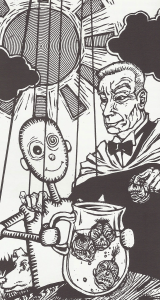 From high school on, I knew I wanted to write roleplaying games. What I didn’t know was how to get that job. In 1997 I responded to an open call online… Atlas Games was looking for submissions for Forgotten Lives, a collection of adventures for Jonathan Tweet’s Over The Edge. I submitted a piece called “Dreaming On The Verge Of Strife”, about conspiracies that only exist in peoples’ dreams… a theme I’d later revisit in Eberron with the Dreaming Dark. The image above is one of Grey Thornberry’s pieces from “Dreaming…” My friend Lee Moyer and I collaborated on a host of ideas for the next OTE anthology, a collection of businesses called At Your Service. “The Rose Hotel” is one of my favorite creations, and a scenario I still enjoy running today.
From high school on, I knew I wanted to write roleplaying games. What I didn’t know was how to get that job. In 1997 I responded to an open call online… Atlas Games was looking for submissions for Forgotten Lives, a collection of adventures for Jonathan Tweet’s Over The Edge. I submitted a piece called “Dreaming On The Verge Of Strife”, about conspiracies that only exist in peoples’ dreams… a theme I’d later revisit in Eberron with the Dreaming Dark. The image above is one of Grey Thornberry’s pieces from “Dreaming…” My friend Lee Moyer and I collaborated on a host of ideas for the next OTE anthology, a collection of businesses called At Your Service. “The Rose Hotel” is one of my favorite creations, and a scenario I still enjoy running today.
Why am I bringing this up now? Because there’s never been a better time for you to explore Over The Edge. For the next nine days, the Bundle of Holding is offering a comprehensive collection of DRM-free Over The Edge PDFs. For $5.95 you get the rulebook, player’s guide, and a novel by Robin D. Laws. If you beat the average price, you get a stack of supplements, including Forgotten Lives and At Your Service.
What is Over The Edge? The tagline is “The roleplaying game of surreal danger.” Set in roughly modern day, it’s based on the bizarre island of Al Amarja – a haven for all manner of conspiracies and curiosities. Mash together Fringe, The Twilight Zone, Naked Lunch, Illuminati and Fear And Loathing In Las Vegas and you’ve got something that tastes like Al Amarja. It’s got a simple rules system that encourages creativity and can handle almost any character you can come up with; I’d describe it in more detail, but hey, for six dollars you can see for yourself. Because of the flexibility of setting and system, it can support many different playstyles. I’ve had players who played simple, serious characters – the secret agent on a mission, the reporter determined to get the Big Story, the local gamer who knows everybody. Others drifted slightly further from the beaten path… a Kaiju trapped in a human body; a cowboy abducted by aliens and dropped off in the present day; Kurt Cobain seen through the lens of Six-String Samurai; Phil Lovecraft, private eye. And then there’s been some very odd characters, such as Zombie Jesus and Five Ducks In A Battlesuit. The beauty of Over The Edge is that the system handles all these concepts with ease – and that the setting can encompass all of them. Over The Edge also includes one of my favorite game mechanics of all time – Robin D. Law’s Cut-Ups Method, included in the Weather The Cuckoo Likes supplement.
Whenever I prepare an Over The Edge adventure, I like to provide the players with the latest issue of Al Amarja Today (something suggested in the rules). Here’s an example…
 To put things in perspective, one of the PCs in the campaign was Jan Brady: Ninja. No one pays attention to Jan Brady… so when she grew up, she put that talent to use as a professional ninja. Of course she continues to be overshadowed by her sister Marcia, who is not only a musical superstar but also a better ninja than Jan. This ties to one of ways OTE influenced Eberron. While the game provides all sort of details about the setting, it encourages you to pick and choose what you want – and to change things to fit your game. In “canon” Over The Edge, the beloved singer-songwriter with the Good Tunes is Karla Sommers. When my friend came to me with the idea of playing Jan, I just changed “Karla” to “Marcia”. It gave me a host of material to work with, but now completely revolving around the PC. That attitude to “canon” – something to serve as a starting point and source of inspiration, not something that limits the game – directly influenced my approach to Eberron.
To put things in perspective, one of the PCs in the campaign was Jan Brady: Ninja. No one pays attention to Jan Brady… so when she grew up, she put that talent to use as a professional ninja. Of course she continues to be overshadowed by her sister Marcia, who is not only a musical superstar but also a better ninja than Jan. This ties to one of ways OTE influenced Eberron. While the game provides all sort of details about the setting, it encourages you to pick and choose what you want – and to change things to fit your game. In “canon” Over The Edge, the beloved singer-songwriter with the Good Tunes is Karla Sommers. When my friend came to me with the idea of playing Jan, I just changed “Karla” to “Marcia”. It gave me a host of material to work with, but now completely revolving around the PC. That attitude to “canon” – something to serve as a starting point and source of inspiration, not something that limits the game – directly influenced my approach to Eberron.
Anyhow: Over The Edge has long been one of my favorite RPGs, and The Bundle of Holding is a fantastic opportunity to pick it up. So check it out!
Stories And Dice
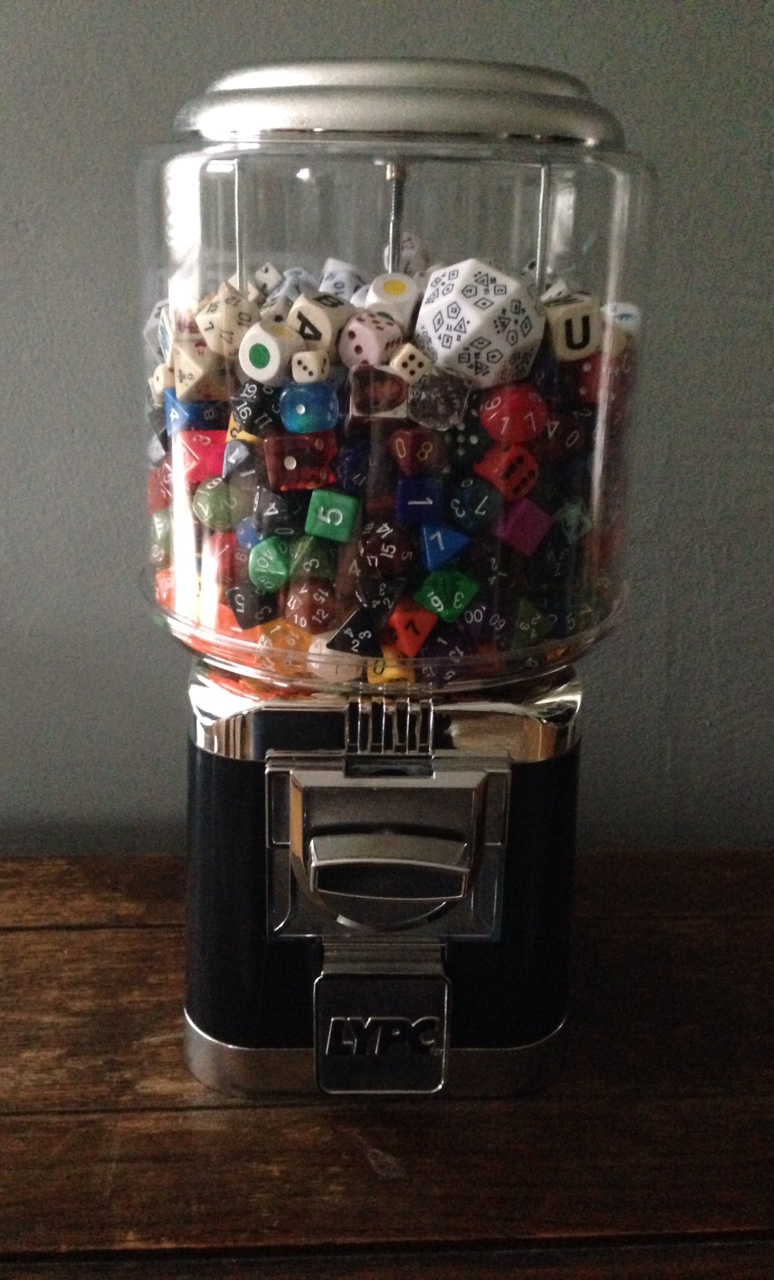 A few years back I told Jenn “You know what would be awesome? A gumball machine filled with dice.” I forgot about it… she didn’t. So meet the newest addition to our house. It’s just as awesome as I expected, but it’s not a small machine. Jenn included a few pounds of dice as part of the present, and I’ve added in all the loose dice I had around the house, but that’s still left us with a significant amount of room at the top. And that gave me an idea.
A few years back I told Jenn “You know what would be awesome? A gumball machine filled with dice.” I forgot about it… she didn’t. So meet the newest addition to our house. It’s just as awesome as I expected, but it’s not a small machine. Jenn included a few pounds of dice as part of the present, and I’ve added in all the loose dice I had around the house, but that’s still left us with a significant amount of room at the top. And that gave me an idea.
As gamers, dice are our faithful (and sometimes treacherous) companions and tools. We have our favorites, we have superstitions, we have memories of amazing critical hits and tragic fumbles. One of my favorite experiences during my Have Dice Will Travel tour was the story of how D&D came to Bulgaria… in particular, how for many years it was very difficult for Bulgarian gamers to acquire dice. A set of dice was a relic to be treasured by a gaming group. At one point the first Bulgarian gamer had to sell some of his dice to raise rent money. Stop and think about that for a moment: you need some significant cash, fast, so what do you do? Sell some dice, right? At the end of my trip to Bulgaria, my guide Stefan gave me one of those very dice (both pictured below), and that little grey die is one of my regulars today. It’s not much to look at, but once upon a time it was one of the only dice in Bulgaria.
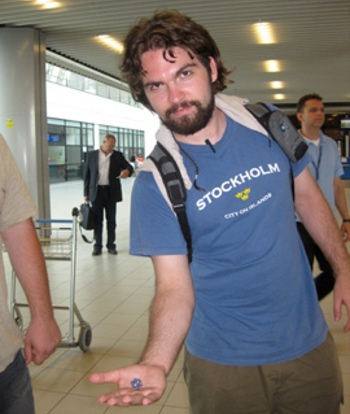 Dice aside, I love hearing people’s stories about how they started gaming, why they play, or favorite moments. It’s especially great to hear from people who have enjoyed something I’ve done – to hear YOUR stories of Eberron, Gloom, or anything else. Last year at Calgary Expo I met a pair of newlyweds who’d met in an Eberron campaign; the year before I met a soldier whose unit played Eberron in Iraq using dice made out of toilet paper.
Dice aside, I love hearing people’s stories about how they started gaming, why they play, or favorite moments. It’s especially great to hear from people who have enjoyed something I’ve done – to hear YOUR stories of Eberron, Gloom, or anything else. Last year at Calgary Expo I met a pair of newlyweds who’d met in an Eberron campaign; the year before I met a soldier whose unit played Eberron in Iraq using dice made out of toilet paper.
So I have a diceball machine with empty space at the top, and thousands of people out there whose stories I haven’t heard. I could just buy another two pounds of dice, but I thought I’d do something different. I want you to send me a die and a story. It doesn’t have to be your favorite die, and it doesn’t have to be an epic story; just tell me something about you. Why do you game? What was one of your favorite moments? If you played in Eberron, what’s the most awesome thing you did there? I’ve made a layer of white at the top of the machine so I can tell where the story dice begin, and if we get enough I’ll drain it from below. Perhaps someday every die in the machine will have a story.
If you’d like to take part, send your die and your story to:
Keith Baker
PO Box 13250
Portland, OR 97213
… or catch up with me in person somewhere! Let me know if it’s all right to share your story with others, and make sure to include your email address so I can follow up with you. And please pass this along to anyone you know who might be interested.
As long as I’m talking about the stories of dice, I’d be remiss if I didn’t mention The Bones, an anthology assembled by the brilliant Will Hindmarch. The Bones includes stories from Kenneth Hite, Matt Forbeck, John Kovalic, and many others… including a more detailed account of my time in Bulgaria.
In the days ahead I’ll be writing about Phoenix, Gloom, and the many exciting projects I’ve got lined up for 2014. I’ll be back with more Eberron Q&As. Until then, I hope you’re having a fantastic holiday, and I hope you’ll share a story with me!
Doom News & Things I’m Backing
The Doom That Came To Atlantic City is one step closer to reality. These resin models were used to create the molds for the playing pieces. Cryptozoic has proof copies of the miniatures and is showing them at Board Game Geek Con, going on in Dallas right now! This is the first time anyone’s been able to play the game with the miniatures, and it’s great to finally be closing in on the end of this particular road. Thanks again to everyone who put their faith in this project, and especially to Cryptozoic for their kindness and generosity.If you get a chance to see the minis at BGGC, let me know what you think!
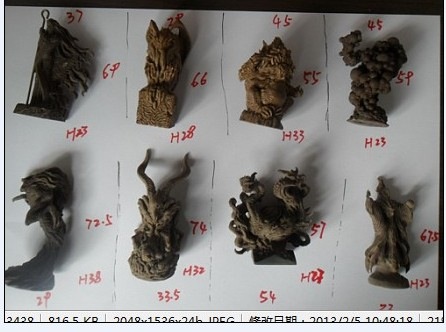 While my experience with The Forking Path was painful and disappointing, I still believe in crowdfunding. I’m planning to kickstart Phoenix next year. The game is coming along and we’re continuing to playtest and hone, but we aren’t going to launch a campaign until we are entirely confident in our production budget and timeline. Having seen what happened with Doom, I have no intention of making those mistakes in my own campaign… and as a result, it’s still going to be a few months before we launch Phoenix. Meanwhile, I’m continuing to back a host of other projects. Some have just wrapped up, like Javier Grillo-Marxuach’s Middleman Crowd-Funded Franchise Resurrection and James Ernest’s card game Get Lucky; I’m looking forward to both of those. But there’s a few others that are still going on, and I thought I’d share.
While my experience with The Forking Path was painful and disappointing, I still believe in crowdfunding. I’m planning to kickstart Phoenix next year. The game is coming along and we’re continuing to playtest and hone, but we aren’t going to launch a campaign until we are entirely confident in our production budget and timeline. Having seen what happened with Doom, I have no intention of making those mistakes in my own campaign… and as a result, it’s still going to be a few months before we launch Phoenix. Meanwhile, I’m continuing to back a host of other projects. Some have just wrapped up, like Javier Grillo-Marxuach’s Middleman Crowd-Funded Franchise Resurrection and James Ernest’s card game Get Lucky; I’m looking forward to both of those. But there’s a few others that are still going on, and I thought I’d share.
An RPG project from Monte Cook and Bruce Cordell, this is a setting that crosses multiple worlds, each with its own unique laws and structures… and your character changes to adapt to each world. I played around with a similar idea a few years back, and I’m keen to see what Monte and Bruce have come up with. The Strange only has 24 hours left, and they’ve already unlocked a host of new material through stretch goals, so check it out quick!
ODYSSEY: A Game of Journeys
Odyssey is a story-driven RPG from Will Hindmarch. I’ve been a fan of Will’s work since we collaborated on Friends of the Dragon many years ago. His pay-what-you-want cyberpunk campaign Always/Never/Now is one of my favorite roleplaying experiences of the last decade. In my opinion, anything Will is involved in is worth a look, and Odyssey is no exception.
ZEPPELDROME
From the minds of Anthony Gallela and Jeff Wilcox comes Zeppeldrome, The Hazardous Dirigible Rally. If you’re like me, you’ve been bemoaning the horrifying dearth of dirigible-based board games on the market today. Zeppeldrome doubles down on this concept, as it’s a dirigible race in which the racecourse is itself in an even larger dirigible. This isn’t just a load of hot air, folks. Well, it is, but it’s also an intriguing game involving a modular board, pre-planned movement, and the ability to interfere with your opponent’s preplanned movement. I haven’t had an opportunity to check it out, but Jenn has, and it gets her seal of approval. So if you’ve been hankering for a quality game about humorously awkward airships, take a look!
Eberron Continued: What Is Canon?
I’ve got a lot of things I want to write about this week – Phoenix, Kickstarter, and more. However, a comment on the last Dragonmark raises an interesting question, namely “What is canon?”
Let’s start with the comment itself.
If you consider DDO to be canon in some way, there is two survivors from the Dragon/Giant war too: The Stormreaver and The Truthful One. They both died in the conclusion of the most recent game raid, but their history had been told since DDO launch.
Excellent point. But what really interests me is “if you consider DDO to be canon…” I am thrilled with everything that DDO has done and the stories that they have created. They have helped to keep Eberron alive over the years in which there’s been little new published material. But personally, I don’t consider that material to be canon… any more than I consider my own novels to be canon. Because in my mind, these are the same thing.
What COULD be considered canon? I could see a case for any of the following.
* Sourcebooks created by Wizards of the Coast.
* Articles created or authorized by Wizards of the Coast – the Dragonshards, Eberron Expanded, articles from DDI, Dragon, or Dungeon.
* Eberron novels authorized by Eberron.
* The lore created for D&D Online.
With that said, when the design team first created Eberron, we made the decision that novels wouldn’t be considered canon. A novel is a particular story that COULD happen in Eberron… but that doesn’t mean it WILL happen. In other words, just because a novel says that Lhesh Haruuc of Darguun dies in 999 YK doesn’t mean that you’ll ever see that mentioned or acknowledged in a sourcebook. In the Dreaming Dark Trilogy Pierce gets an artifact – the Docent Shira. When I wrote Secrets of Xen’drik, I included game stats for Shira. But I didn’t mention Pierce. Because if you want to use Shira in your campaign, I want YOU to decide what happens to her. So in a sense, SHIRA is canon – covered in a core sourcebook – while Pierce is not. In my opinion, DDO is in the same category as a novel. If DDO does something with the Lord of Blades that contradicts what you’ve done with him, you aren’t somehow wrong. DDO is one possible story, just like the novels. But it’s not any more important than your story.
This raises the bigger question: What is the purpose of canon? In my opinion, having canon material gives players and gamemasters a common language. It lets players from different groups share stories. It gives them something to expect. It can inspire stories and adventures. I can go into an Eberron game and tell the DM “What I really want to do is to investigate the Mourning.” Canon provides the major pillars that carry the setting… The Last War, the Mourning, the Treaty of Thronehold, the Dragonmarked Houses, the Prophecy. I may not know the specific details a DM has decided (such as the cause of the Mourning), but I know the Mourning is a major force in the world. Canon creates a CONTEXT. In my opinion, canon is most useful as a source of inspiration, when the ideas of the Lords of Dust or Lhesh Haruuc’s successor or the Race of Eight Winds or whatever gives you an idea for a story and gives the PCs context to fill in all the little details around it. What I don’t want is for it to limit you. Case in point, in the last Dragonmark someone asked if Eberron had legends of sunken lost continents. None of the material I’ve written does; in developing the setting I focused more on creating civilizations for the aquatic races than on having sunken surface nations. But as a DM, the LACK of canon information shouldn’t stop you from creating your own sunken nation. And regardless of what a novel says, you should feel free to kill Lhesh Haruuc, keep him alive, or just replace him entirely with this cool bugbear you’ve developed.
Beyond this: I might say “Sourcebooks are canon, but novels aren’t.” But the fact of the matter is that *I* don’t use everything in the sourcebooks. For example, I feel that the depiction of Thrane in The Forge of War runs counter to its depiction in other sources and to my personal vision of the nation… and thus, I ignore it. So in my campaign, The Forge of War isn’t canon. Meanwhile, you might decide that since you and your players love the Legacy of Dhakaan books, you want to make the events and characters in that book part of your story. So for you, it’s canon. When we talk about our respective campaigns, I can say “I’ve made DDO and the Thorn of Breland canon, but I’m ignoring the other novels”… and that lets you know what to expect, and gives you information you can use in creating your own character and story.
Ultimately, “canon” is a tool that helps you and your players understand the world. It creates a common language for storytelling. So what’s really important isn’t the broad generic canon, but the canon for your campaign. Personally, I’d suggest that you tell players what’s going to be canon when you start a campaign. If you like certain novels, you can say “These novels are canon.” If you hate a particular sourcebook, mention that you aren’t using it. What’s important is creating YOUR canon.
So… that’s my long rant on canon material. What do YOU think? Do you personally use the events of the novels and DDO in your campaigns? Do you feel that encouraging DMs to make the world their own is a strength of the setting, or a weakness?

